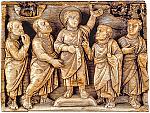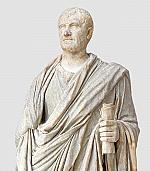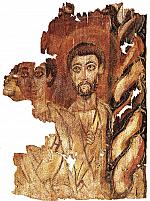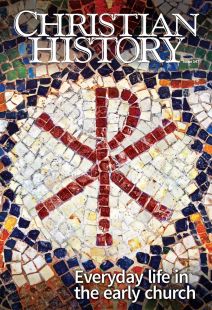“According to custom”

[Miniature replica of the Holy Sepulchre of Jerusalem, 5th century—Zunkir / [CC-BY-SA 4.0] WIKIMEDIA]
A few decades after Christianity was legalized in the Roman Empire, Egeria, a woman from western Europe, traveled to Jerusalem and wrote about what she saw, including the round of public daily prayer.
While the public nature of many of these ceremonies depended on Christianity’s legalization, they grew out of an earlier round of daily prayer in homes and other Christian gatherings.
Every day before cockcrow all the doors of the Anastasis [Church of the Holy Sepulchre or Church of the Resurrection] are opened, and all the monks and virgins . . . descend, and not only these, but also the laity, both men and women, who desire to have an early vigil. From that hour to daybreak hymns are sung, and psalms and antiphons sung in response. And after each hymn prayer is offered.
For two or three priests at a time, and likewise the deacons, have their turns every day along with the monks, to say prayers after each hymn or antiphon.
When day begins to break then they begin to sing the matin [i.e., morning prayer] hymns. Then the bishop arrives with the clergy and forthwith enters the cave [i.e., the actual sepulchre believed to be Christ’s tomb], and from within the [altar] rails he first says a prayer for all; then he commemorates the names of those whom he wishes, and blesses the catechumens [i.e. those preparing for baptism].
Then he says another prayer and blesses the faithful; and next, as the bishop comes out from within the rails, they all approach [to kiss] his hands, and blessing them one by one, he departs, and so the dismissal is given with the dawn.
At the sixth hour they all go down again to the Anastasis, and psalms and antiphons are sung until the bishop is summoned . . . in like manner, he first offers prayer, then blesses the faithful, and then, as he comes out from the rails, they approach [to kiss] his hands as before. And so is it done at the ninth hour as at the sixth.
Night and day
At the tenth hour . . . [comes] the service of lights—in like manner the crowd collects at the Anastasis; all the candles and wax-tapers are lit, and a great light is made. But the light is not brought from outside; it is fetched from the inner cave, where a lamp burns night and day, i.e., from inside the rails; the vesper psalms are sung, and the antiphons for a good while. But lo! the bishop is summoned, and he comes down and sits on high; also the priests sit in their places; hymns and antiphons are sung.
And when [the hymns and antiphons] have been recited according to custom, the bishop gets up and stands before the chancel [i.e., the front of the church] . . . before the cave, and one of the deacons makes a commemoration of [i.e., prayer for] individuals, as is the custom. And while the deacon recites the names of the individuals, many boys stand responding Kyrie eleison, as we say, Lord, have mercy upon us. . . .
And when the deacon has recited all that he has to say, first the bishop says a prayer and prays for all; and then they all pray, the faithful and the catechumens together. And then the deacon calls out for each catechumen to bow his head where he stands; and so the bishop, standing, pronounces a blessing over the catechumens.
Again prayer is offered, and again the deacon lifts his voice and warns the faithful, standing, to bow their heads. And then the bishop blesses the faithful, and so the dismissal is given. . . . And they begin [one by one] to approach [to kiss] the hands of the bishop.
Afterwards the bishop is escorted from the Anastasis to the cross [i.e., Golgotha] with hymns, and all the people go with him. When they have arrived he first offers a prayer, then he blesses the catechumens; then another prayer is offered, then he blesses the faithful.
And after that the bishop and the whole crowd go behind the cross, and there are there again similar ceremonies. . . . All these ceremonies are finished in the dark.
By Egeria
[Christian History originally published this article in Christian History Issue #147 in 2023]
Egeria. Translated by John Henry Bernard.Next articles
Serving the true Lord and God
Why Christians presented such a huge challenge to the Roman state
George Kalantzis“This superstition”
Pliny, Roman governor of Bithynia in the early second century, asks for advice on how to deal with the Christian movement
PlinyThe emperor and the desert
Christian commitment to asceticism grew in a newly legalized faith
Kate CooperSupport us
Christian History Institute (CHI) is a non-profit Pennsylvania corporation founded in 1982. Your donations support the continuation of this ministry
Donate







